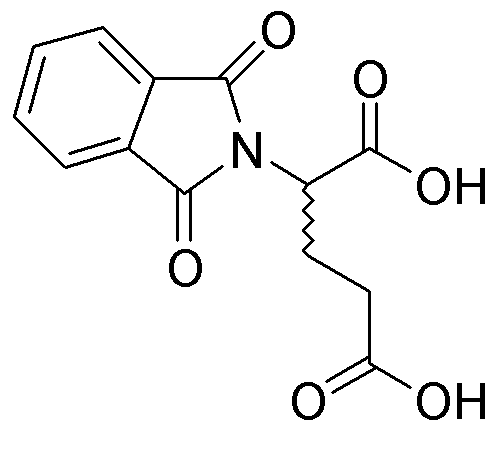Phthaloyl-DL-glutamic acid is widely utilized in research focused on:
- Pharmaceutical Development: This compound serves as an important intermediate in the synthesis of various pharmaceuticals, particularly in the development of drug delivery systems that enhance bioavailability.
- Biopolymer Production: It is used in the formulation of biodegradable polymers, which are increasingly important in reducing environmental impact and improving sustainability in packaging and medical applications.
- Analytical Chemistry: Researchers employ this compound as a reagent in analytical methods to detect and quantify amino acids and peptides, aiding in the development of new diagnostic tools.
- Food Industry: It finds applications as a food additive, where it can enhance flavor profiles and improve the stability of food products, contributing to better shelf life.
- Cosmetic Formulations: The compound is incorporated into cosmetic products for its potential skin benefits, acting as a stabilizer and enhancing the texture of creams and lotions.
General Information
Properties
Safety and Regulations
Applications
Phthaloyl-DL-glutamic acid is widely utilized in research focused on:
- Pharmaceutical Development: This compound serves as an important intermediate in the synthesis of various pharmaceuticals, particularly in the development of drug delivery systems that enhance bioavailability.
- Biopolymer Production: It is used in the formulation of biodegradable polymers, which are increasingly important in reducing environmental impact and improving sustainability in packaging and medical applications.
- Analytical Chemistry: Researchers employ this compound as a reagent in analytical methods to detect and quantify amino acids and peptides, aiding in the development of new diagnostic tools.
- Food Industry: It finds applications as a food additive, where it can enhance flavor profiles and improve the stability of food products, contributing to better shelf life.
- Cosmetic Formulations: The compound is incorporated into cosmetic products for its potential skin benefits, acting as a stabilizer and enhancing the texture of creams and lotions.
Documents
Safety Data Sheets (SDS)
The SDS provides comprehensive safety information on handling, storage, and disposal of the product.
Product Specification (PS)
The PS provides a comprehensive breakdown of the product’s properties, including chemical composition, physical state, purity, and storage requirements. It also details acceptable quality ranges and the product's intended applications.
Certificates of Analysis (COA)
Search for Certificates of Analysis (COA) by entering the products Lot Number. Lot and Batch Numbers can be found on a product’s label following the words ‘Lot’ or ‘Batch’.
Numéro de catalogue
Numéro de lot/série
Certificates Of Origin (COO)
This COO confirms the country where the product was manufactured, and also details the materials and components used in it and whether it is derived from natural, synthetic, or other specific sources. This certificate may be required for customs, trade, and regulatory compliance.
Numéro de catalogue
Numéro de lot/série
Safety Data Sheets (SDS)
The SDS provides comprehensive safety information on handling, storage, and disposal of the product.
DownloadProduct Specification (PS)
The PS provides a comprehensive breakdown of the product’s properties, including chemical composition, physical state, purity, and storage requirements. It also details acceptable quality ranges and the product's intended applications.
DownloadCertificates of Analysis (COA)
Search for Certificates of Analysis (COA) by entering the products Lot Number. Lot and Batch Numbers can be found on a product’s label following the words ‘Lot’ or ‘Batch’.
Numéro de catalogue
Numéro de lot/série
Certificates Of Origin (COO)
This COO confirms the country where the product was manufactured, and also details the materials and components used in it and whether it is derived from natural, synthetic, or other specific sources. This certificate may be required for customs, trade, and regulatory compliance.


